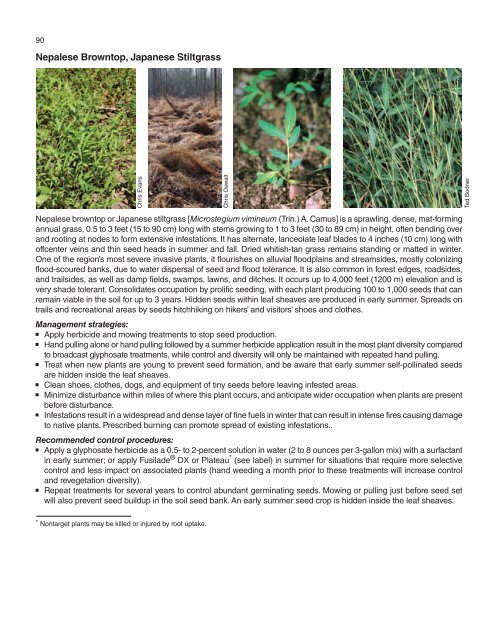A Management Guide for Invasive Plants in Southern Forests James ...
A Management Guide for Invasive Plants in Southern Forests James ...
A Management Guide for Invasive Plants in Southern Forests James ...
- No tags were found...
Create successful ePaper yourself
Turn your PDF publications into a flip-book with our unique Google optimized e-Paper software.
90Nepalese Browntop, Japanese StiltgrassChris EvansChris OswaltTed BodnerNepalese browntop or Japanese stiltgrass [Microstegium vim<strong>in</strong>eum (Tr<strong>in</strong>.) A. Camus] is a sprawl<strong>in</strong>g, dense, mat-<strong>for</strong>m<strong>in</strong>gannual grass, 0.5 to 3 feet (15 to 90 cm) long with stems grow<strong>in</strong>g to 1 to 3 feet (30 to 89 cm) <strong>in</strong> height, often bend<strong>in</strong>g overand root<strong>in</strong>g at nodes to <strong>for</strong>m extensive <strong>in</strong>festations. It has alternate, lanceolate leaf blades to 4 <strong>in</strong>ches (10 cm) long withoffcenter ve<strong>in</strong>s and th<strong>in</strong> seed heads <strong>in</strong> summer and fall. Dried whitish-tan grass rema<strong>in</strong>s stand<strong>in</strong>g or matted <strong>in</strong> w<strong>in</strong>ter.One of the region’s most severe <strong>in</strong>vasive plants, it flourishes on alluvial floodpla<strong>in</strong>s and streamsides, mostly coloniz<strong>in</strong>gflood-scoured banks, due to water dispersal of seed and flood tolerance. It is also common <strong>in</strong> <strong>for</strong>est edges, roadsides,and trailsides, as well as damp fields, swamps, lawns, and ditches. It occurs up to 4,000 feet (1200 m) elevation and isvery shade tolerant. Consolidates occupation by prolific seed<strong>in</strong>g, with each plant produc<strong>in</strong>g 100 to 1,000 seeds that canrema<strong>in</strong> viable <strong>in</strong> the soil <strong>for</strong> up to 3 years. Hidden seeds with<strong>in</strong> leaf sheaves are produced <strong>in</strong> early summer. Spreads ontrails and recreational areas by seeds hitchhik<strong>in</strong>g on hikers’ and visitors’ shoes and clothes.<strong>Management</strong> strategies:Apply herbicide and mow<strong>in</strong>g treatments to stop seed production.Hand pull<strong>in</strong>g alone or hand pull<strong>in</strong>g followed by a summer herbicide application result <strong>in</strong> the most plant diversity comparedto broadcast glyphosate treatments, while control and diversity will only be ma<strong>in</strong>ta<strong>in</strong>ed with repeated hand pull<strong>in</strong>g.Treat when new plants are young to prevent seed <strong>for</strong>mation, and be aware that early summer self-poll<strong>in</strong>ated seedsare hidden <strong>in</strong>side the leaf sheaves.Clean shoes, clothes, dogs, and equipment of t<strong>in</strong>y seeds be<strong>for</strong>e leav<strong>in</strong>g <strong>in</strong>fested areas.M<strong>in</strong>imize disturbance with<strong>in</strong> miles of where this plant occurs, and anticipate wider occupation when plants are presentbe<strong>for</strong>e disturbance.Infestations result <strong>in</strong> a widespread and dense layer of f<strong>in</strong>e fuels <strong>in</strong> w<strong>in</strong>ter that can result <strong>in</strong> <strong>in</strong>tense fires caus<strong>in</strong>g damageto native plants. Prescribed burn<strong>in</strong>g can promote spread of exist<strong>in</strong>g <strong>in</strong>festations..Recommended control procedures:Apply a glyphosate herbicide as a 0.5- to 2-percent solution <strong>in</strong> water (2 to 8 ounces per 3-gallon mix) with a surfactant<strong>in</strong> early summer; or apply Fusilade ® DX or Plateau * (see label) <strong>in</strong> summer <strong>for</strong> situations that require more selectivecontrol and less impact on associated plants (hand weed<strong>in</strong>g a month prior to these treatments will <strong>in</strong>crease controland revegetation diversity).Repeat treatments <strong>for</strong> several years to control abundant germ<strong>in</strong>at<strong>in</strong>g seeds. Mow<strong>in</strong>g or pull<strong>in</strong>g just be<strong>for</strong>e seed setwill also prevent seed buildup <strong>in</strong> the soil seed bank. An early summer seed crop is hidden <strong>in</strong>side the leaf sheaves.* Nontarget plants may be killed or <strong>in</strong>jured by root uptake.
















